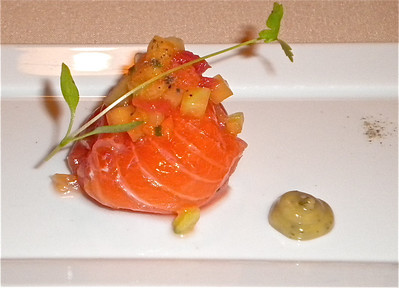This summer it seems as though everyone whom I know has come down with Swedish fever. Maybe you have friends suffering from this affliction, too. They clutch dog-eared copies of Stieg Larsson’s “The Girl Who Played with Fire” and sit on the edge of their Ikea-designed seats, watching the film adaptation of Larsson’s “The Girl with the Dragon Tattoo” over and over again. When not hashing over missing Larsson manuscripts or the Kenneth Branagh series “Wallander,” they pound the pavement in search of gravlax and good, strong aquavit.
Believe me, I’m not scoffing at their plight. In fact, I’m battling a similar addiction. From ethereal cloudberry preserves and delicately flavored kanelbullar to hearty root vegetables and tangy fish I’m completely hooked on the wholesome cuisine of Sweden.

It all started with gravlax. Often confused with smoked salmon, gravlax is raw salmon cured in a mixture of salt, sugar and dill. Similar to its smoked cousin, this Swedish specialty originated from the need to store fish in a time when refrigeration did not exist.
In medieval times fishermen salted their freshly caught salmon, wrapped them in birch bark, and then buried them in the ground. This burial protected the macerating fish from wild and ravenous animals. It also provided the preserved salmon with its name. In Swedish “grav” means “tomb” or “grave” while “lax” refers to salmon.
Today’s gravlax skips the birch bark and underground burial. Instead, after being cured with salt, sugar and dill, the salmon is sealed in plastic and refrigerated for 24 to 48 hours. After that time it’s removed from the fridge, rinsed cleaned and then thinly sliced. Once sliced, gravlax will keep for up to 5 days in the refrigerator.
In my case gravlax never hangs around for a full 5 days. No sooner have I bought gravlax than I’m ripping open the package and nibbling on a piece. Thanks to its velvety, melt-in-your-mouth texture, subtle aroma, and mildly piquant flavor, it’s become one of my favorite savory treats.
I first sampled gravlax at a quintessentially Swedish place, a smorgasbord. Here paper-thin, coral-colored slices overlapped on a stark white ceramic platter. A border of fresh, feathery dill surrounded them. Pretty to behold, gravlax was even better to eat.
And eat I did. I devoured it atop wedges of dark brown bread, alongside poached eggs, and with stewed potatoes. When I ran out of bread, eggs or potatoes, I ate it on its own with a dollop of sweet mustard sauce. Every bite was an utter delight. And with that my passion for gravlax and all-things-Swedish began.
GRAVLAX WITH SWEET MUSTARD SAUCE
Adapted from “Very Swedish” by Annica Triberg, Per Ranung and Tore Hagman (Bokförlaget Max Ström, 2007)
For the gravlax:
2 1/4 pounds salmon fillet, de-boned but with the skin intact
3 1/2 ounces sugar
1 TBSP coarsely ground white pepper
4 ounces iodized salt
3 handfuls fresh dill
For the sauce:
1 TBSP mild mustard
1 TSP Dijon mustard
1 TBSP sugar
2 TBSP red wine vinegar
1/2 cup oil (not olive)
1/4 cup finely chopped dill
Mix together the sugar, salt and pepper and massage it into both sides of the salmon. Spread the dill on the meat (not skin) side. Place the fish in a plastic bag, seal the bag, put it on a plate and place a heavy cutting board on top of it. Allow the fish to rest at room temperature for 2 hours. After 2 hours have passed, remove the cutting board and refrigerate the salmon for 24 to 48 hours, turning it 3 to 4 times during this period.
Remove the fish from the refrigerator, dry it off and scrape off the seasonings. Slice thinly and either serve or refrigerate. Gravlax will keep for 4 to 5 days in the fridge and can also be deep-frozen.
For the sauce, mix together the mustards, sugar and vinegar. Drizzle in the oil while mixing swiftly. Stir in the chopped dill. Set aside in a cool place.